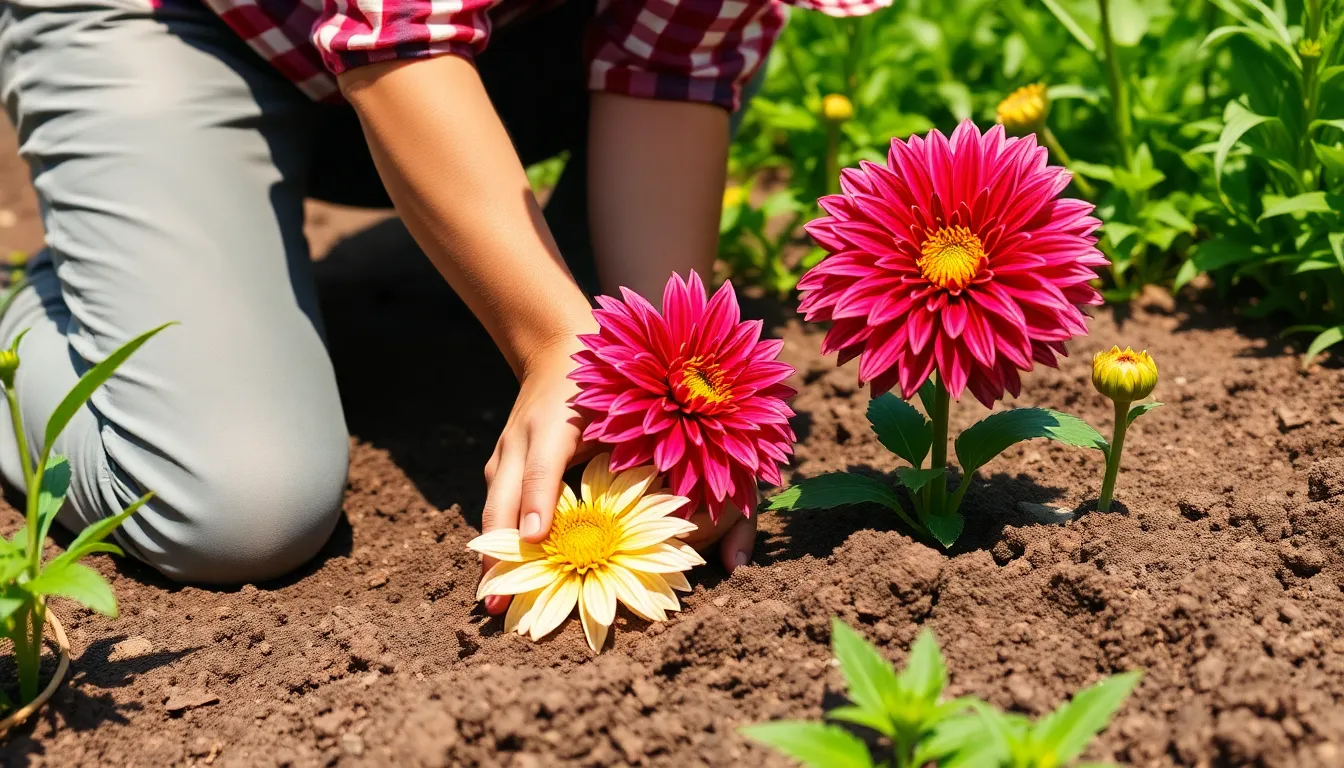Dahlias are the divas of the garden world, flaunting their vibrant blooms like they own the place. With their dazzling colors and unique shapes, they can make any garden look like a floral runway. But don’t let their beauty fool you; these beauties require a bit of TLC to truly thrive.
dahlia plant care
Dahlias stand out in gardens for their vibrant colors and unique forms. These flowers require precise care to thrive, making knowledge of their types and ideal growing conditions essential.
Types of Dahlias
Dahlias come in various types, each offering distinct characteristics. Decorative dahlias exhibit large blooms and a more rounded shape. Cactus dahlias feature spiky petals, adding texture to gardens. Anemone dahlias showcase inner petals surrounded by longer outer petals, creating a striking look. Pompon dahlias present small, ball-shaped flowers, perfect for compact spaces. Each type serves different landscaping needs and aesthetic preferences.
Ideal Growing Conditions
Dahlias flourish best in specific environmental conditions. Here, full sun exposure, ideally six to eight hours daily, proves crucial for vibrant blooms. Well-draining soil enriched with organic matter promotes healthy growth and root development. Regular watering, particularly during dry spells, sustains their vitality. Maintaining a slightly acidic to neutral pH range (6.0 to 7.0) supports optimal nutrient uptake. Understanding these ideal conditions ensures healthy, stunning dahlias.
Planting Dahlias

Planting dahlias correctly ensures robust growth and vibrant blooms. Selecting the right timing and preparing the soil are crucial for success.
Timing and Location
Choose late spring to plant dahlias after the risk of frost ends. Selecting a site with ample sunlight promotes healthy growth. Locations that receive six to eight hours of sunlight daily favor full bloom. Spacing plants at least 18 inches apart allows adequate airflow. Observing local climate conditions ensures optimal planting times.
Soil Preparation
Prepare the soil to promote drainage and fertility. A well-drained, loamy soil enriched with organic matter supports healthy root development. Testing the soil pH is advisable; a slightly acidic to neutral range enhances dahlia health. Incorporating compost or aged manure improves nutrient levels. Tilling the soil to a depth of 12 inches aids in loosening compacted ground, thus allowing roots to establish more effectively.
Watering and Feeding
Dahlia plant care includes a consistent watering and feeding routine. Proper hydration and nutrition significantly impact their growth and blooming.
Watering Schedule
Dahlias require regular watering, especially during dry spells. Watering twice a week ensures that the soil remains moist but not waterlogged. Container plants may need more frequent watering due to quicker drying. Early morning is the best time for watering to reduce evaporation losses. Monitoring weather conditions helps in adjusting the watering frequency accordingly. Consider using mulch to retain soil moisture and regulate temperature.
Fertilization Tips
Fertilization enhances dahlia growth and bloom quality. Starting with a balanced fertilizer, applying a 10-10-10 or similar ratio, supports initial growth. Feed dahlias every 4-6 weeks for continuous nourishment. Additionally, consider a fertilizer higher in phosphorus during bloom to promote vibrant flowers. Organic options like compost or fish emulsion also work effectively and enrich the soil. Avoid over-fertilizing, as it can lead to lush foliage but fewer blooms.
Pruning and Maintenance
Dahlia plants thrive with proper pruning and maintenance practices. Regular attention ensures healthy growth and abundant blooms.
Deadheading Techniques
Deadheading involves removing spent flowers, which promotes further blooming. Utilize sharp, clean shears for the task, making cuts just above the next set of leaves. This encourages the plant to focus energy on developing new flowers rather than seed production. Perform deadheading throughout the blooming season to maximize each plant’s potential. Checking for dead blooms at least once a week allows for consistent maintenance.
Supporting Tall Varieties
Tall dahlia varieties require additional support to prevent breakage from rain or wind. Installing sturdy stakes or cages at planting time offers essential stability. Tying stems loosely to the supports helps maintain an upright position while allowing room for growth. Assessing the plants regularly during their growing season facilitates timely adjustments to support structures as needed. Providing adequate support results in healthier plants and more vibrant displays.
Dealing with Pests and Diseases
Dahlia plants can encounter various pests and diseases that threaten their health. Awareness of these issues leads to proactive management strategies.
Common Pests
Aphids frequently infest dahlias, often found on new growth. Look for small, green insects that may cause leaf curling. Slugs and snails can also damage plants, eating through leaves and stems. Spider mites thrive in hot, dry conditions and cause stippling on leaves. Treat infestations using insecticidal soap or neem oil to keep plants safe from harm. Regular inspection helps catch these pests early, enabling immediate action.
Disease Management Strategies
Fungal infections like powdery mildew can affect dahlias, particularly in humid environments. Ensure proper spacing for airflow and use organic fungicides for treatment. Bacterial wilt, caused by infected beetles, leads to wilting and yellowing. Remove any affected plants promptly to prevent spread. Rotating crops and avoiding overcrowded conditions also reduce disease risk. Understanding these strategies boosts the likelihood of healthy, vibrant dahlia blooms.
Conclusion
Caring for dahlias can transform any garden into a vibrant oasis. With their stunning colors and unique shapes they require dedicated attention to thrive. By understanding their specific needs in terms of sunlight soil and water gardeners can ensure these beautiful blooms flourish throughout the growing season.
Regular maintenance practices like deadheading and supporting taller varieties play a crucial role in promoting healthy growth. Additionally staying vigilant against pests and diseases will help protect these plants from common threats. With the right care and knowledge anyone can enjoy the breathtaking beauty of dahlias in their garden.

